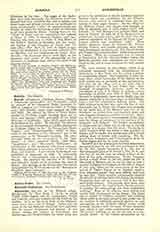

Auriesville, the site of the Mohawk village, Montgomery Co., New York, U.S.A., in which Father Isaac Jogues and his companions, Goupil and Lalande, were put to death for the Faith by the Indians. It is on the south bank of the Mohawk, about forty miles west of Albany. Auries was the name of the last Mohawk who lived there, and from this the present designation was formed. It was known among the Indians as Ossernenon, also Gandawaga and Caughnawaga, the latter being also given to the settlement on the St. Lawrence opposite Lachine which was established for the Iroquois converts who wanted to withdraw from the corruption of their pagan kinsmen. To the village on the Mohawk Jogues and Goupil were brought in 1642 as prisoners, and, in 1646, Jogues again, with Lalande. In 1644 Bressani was tortured there, and later on Poncet. In 1655-56-57 Le Moyne came as ambassador to make peace; and the year after the punitive expedition of the Marquis de Tracy a permanent mission was established (1667). There Father Boniface, James de Lamberville, Fremin Bruyas, Pierron, and others labored until 1684, when the mission was destroyed. The famous Indian girl, Tegakwitha, was born there. From it she escaped to Canada. While the missionaries were in control of Ossernenon and the adjacent Indian towns, the Mohawk converts were remarkable for their exact Christian life, and in many instances for their exalted piety.
The exact location of this village, which is so intimately associated with the establishment of Christianity in New York, was for a time a subject of considerable dispute. The researches of John Gilmary Shea, whose knowledge of the history of the early mission was so profound, at first favored the view that the old village was on the other side of the Mohawk at what is now Tribes Hill. More thorough investigations, however, aided by the conclusions of Gen. J. S. Clarke of Auburn, whose knowledge of Indian sites both in New York and Huronia is indisputable, have shown finally that the present Auriesville is the exact place in which Father Jogues and his companions suffered death. The basic evidence is the fact that, up to the time of their destruction by de Tracy, the villages were certainly on the south side of the Mohawk and west of the Schoharie—as is clear from contemporary maps, and from Jogues’s, Bressani’s, and Poncet’s letters. Joliet, one of the most accurate cartographers of the time, puts the village of Ossernenon at the junction of the Schoharie and Mohawk. To further particularize it, Jogues said the village was on the top of the hill, a quarter of a league from the river. The ravine in which Goupil’s body was found is also specified by Jogues, and he speaks of a watercourse and a rivulet uniting there—a feature still remaining. The distances from Andagaron and Tionontoguen given by Father Jogues also fix the exact locality.
Satisfied that the precise spot had been determined, ten acres of land on the hill were purchased in 1884 by the Rev. Joseph Loyzance, S.J., who was at that time parish priest of St. Joseph‘s, Troy, N. Y., and who had all his life been an ardent student of the lives of the early missionaries. Father Loyzance erected a small shrine on the hill, under the title of Our Lady of Martyrs, and he was the first to lead a number of pilgrims to the place, on the 15th of August of that year, which was the anniversary of the first arrival of Father Jogues as an Iroquois captive. Four thousand people went from Albany and Troy on that day. Other parishes subsequently adopted the practice of visiting Auriesville during the summer. Frequently there are as many as four or five thousand people present. The grounds have been since extended beyond the original limits, for the purpose of keeping the surroundings free from undesirable buildings. Many of the pilgrims come fasting and receive Holy Communion at the shrine. The entire day is passed in religious exercises, but anything which could in the least savor of any public cult of the martyrs is sedulously guarded against, as such anticipation of the Church‘s official action would seriously interfere with the cause of their canonization, which is now under consideration at Quebec. The present buildings on the site are only of a temporary nature. If the Church pronounces on the reality of the martyrdom of the three missionaries, more suitable edifices will be erected.
T.J. CAMPBELL

